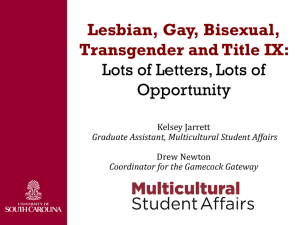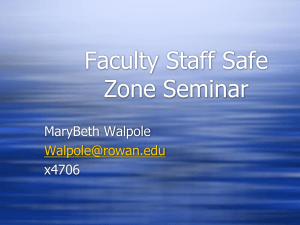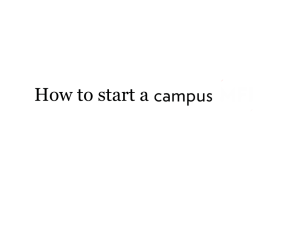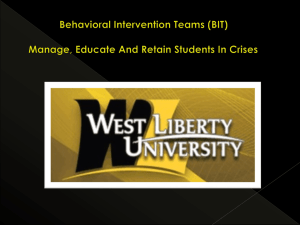Gay and Lesbian Identity Development Model
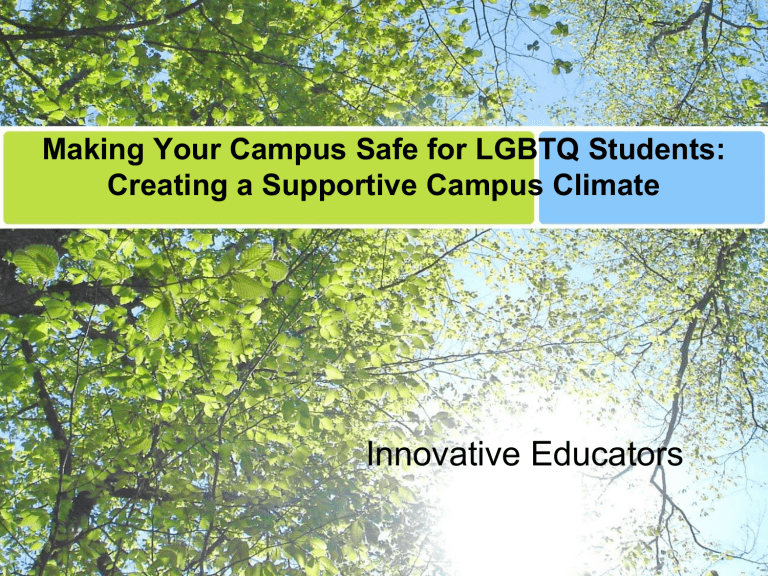
Making Your Campus Safe for LGBTQ Students:
Creating a Supportive Campus Climate
Innovative Educators
“We learn the best when we are able to open up and truly listen to others.”
Shane Windmeyer
Your Presenter
MJ Raleigh, Ph.D. is the director of counseling services at St. Mary’s College of
Maryland since 2008. My doctoral work focused on the interaction between natural environments and mental health. As a therapist I specialize in college student development. I am currently the chair of the
American College Counseling Association
(ACCA) LGBT workgroup and incoming ACCA president. I have over 20 years of experience working with LGBT college students.
Goals
•
•
•
•
•
Participants will learn:
How to challenge LGBT focused violence
Ways to improve the campus climate for LGBT students
Programming efforts that will support creating a safer LGBT campus
Critical ways to support the LGBT community on campus
Overview of identity development and the interaction between healthy development and the campus environment.
Bullying and LGBT issues: Before
College
• 9 out of 10 LGBT students have experienced harassment at school.
• LGBT teens are bullied 2 to 3 times more than straight peers.
• More than 1/3 of LGBT teens attempt suicide.
• 4x more likely to attempt suicide compared to straight peers.
• Students from highly rejecting families are 8x more likely to attempt suicide when compared to
LGBT students with accepting families.
Data adapted from “It Gets Better” and “Stop Bullying Now” campaigns
Bullying and LGBT issues:
Before College
• Openly (or “out”) LGBT teens are a higher risk for violence.
• This hostility can result in running away, dropping out of college, abusing alcohol and drugs, engaging in criminal activity, and self injurious behaviors.
• GLBT students hear anti-gay slurs approximately 26 times a days, 1 comment every 14 minutes.
Once A Student Gets to Campus
It gets better….right?
Once students get to campus:
True or False:
LGBT students have more contact with their faculty members compared to ‘straight’ students.
True
Once students get to campus:
True or False:
LGBT students differ from ‘straight’ or ‘more out’ peers in the degree of academic challenge they report.
False
Once students get to campus:
True or False:
‘More out’ LGBT students reported being more active and collaborative compared to straight or less out peers.
True
Once students get to campus:
True or False:
‘ More out’ LGBT students were less likely to report (on the NSSE) an enriched educational experience. (Experiencing diversity, study a foreign language, study abroad, work with faculty on research.)
False
Once students get to campus:
True or False:
Students who identified as gay or similar reported being the target of derogatory comments (66%).
True
Once students get to campus:
True or False:
Students who identified as lesbian or similar reported being ignored or excluded (53%).
True
Once students get to campus:
True or False:
LGBT students rated their campus environment as positively as did their ‘straight’ peers.
False – rated LESS positively
Once students get to campus:
True or False:
‘Less out’ LGBT students perceived the campus to be less supportive when compared to their
‘more out’ or ‘straight’ peers.
True
Once students get to campus:
True or False:
LGBT students report more harassment when compared to LGBT faculty/staff on the same campus.
True
Once students get to campus:
• Students who identify as transmasculine, transfeminine and/or gender non-conforming experienced harassment and discrimination at higher rates compared to LGBT peers who identified as man or woman.
• Multiple minority identities (LGBT, female, color, ethnicity etc) lead to encountering multiple forms of oppression.
• Students who identified as queer or similar reported being stared at or singled out as an
‘authority’ on LGBT issues (45%).
What we know about campus climate
Maslow’s hierarchy of needs emphasizes the importance of meeting the need for safety before any other needs can be met.
Without a sense of safety essential psychological, cognitive and physical development, along with learning and an overall sense of well-being can not happen.
LGBT students report not feeling safe on campus*.
*Rankin, S., Weber, G., Blumenfeld, W. & Frazer, S. (2010) 2010 State of Higher Education for Lesbian,
Gay, Bisexual and Transgender People. Campus Pride: Charlotte.
College Students:
• Come to college at different stages of identity development.
• Continue through this development at different paces.
• Leave the institution at different stages of development.
• Development is not linear, does not always move forward, it can be regressive, foreclosed, repressed, or stalled.
Gay and Lesbian Identity Development Model
(Cass Identity Model)
Stage 1: Identity Confusion
This is the "Who am I?" stage associated with the feeling that one is different from peers, accompanied by a growing sense of personal alienation.
Gay and Lesbian Identity Development Model
(Cass Identity Model)
Stage 2: Identity Comparison
Rationalization or bargaining stage where the person thinks, "I may be a homosexual, but then again I may be bisexual," "Maybe this is just temporary," or, "My feelings of attraction are simply for just one other person of my own sex and this is a special case."
Gay and Lesbian Identity Development Model
(Cass Identity Model)
Stage 3: Identity Tolerance
In this "I probably am" stage, the person begins to contact other LGBT people to counteract feelings of isolation and alienation, but merely tolerates rather than fully accepts a gay or lesbian identity. The feeling of not belonging with heterosexuals becomes stronger.
Gay and Lesbian Identity Development Model
(Cass Identity Model)
Stage 4: "Identity Acceptance"
There is continued and increased contact with other gay and/or lesbian people in this stage, where friendships start to form.
Gay and Lesbian Identity Development Model
(Cass Identity Model)
Stage 5: "Identity Pride“
"These are my people" stage where the individual develops an awareness of the enormous incongruity that exists between the person's increasingly positive concept of self and an awareness of society's rejection of this orientation. The person feels anger at heterosexuals and may devalue many of their institutions
(e.g. marriage, gender-role structures, etc.)
Gay and Lesbian Identity Development Model
(Cass Identity Model)
Stage 6: "Identity Synthesis“
Intense anger at heterosexuals -- the "them and us" attitude that may be evident in stage 5 -softens at this stage to reflect a recognition that some heterosexuals are supportive and can be trusted. However, those who are not supportive are further devalued. There remains some anger at the ways that lesbians and gays are treated in this society, but this is less intense.
Adapted from Vivian Cass (1979, 1984, 1990). In Ritter and Terndrup (2002). Handbook of Affirmative
Psychotherapy with Lesbians and Gay Men
Case Study: Robby
Robby is a 19 year old new student majoring in mathematics with a 3.8 current GPA. Robby was ‘out’ during high school, was the president of the high school
GLBT student group, parents are the chairpersons of the local PFLAG group and family members participate in several community level awareness events. Upon entering college Robby did not share any personal information about sexuality or gender with peers and felt that it was critical to wait to sense the campus climate. After hearing negative comments on campus Robby has “returned to the closet”, grades are beginning to slip, and has stopped dating. Parents are now calling the Dean of Students concerned that Robby is quiet, seems depressed, is not going out on campus and these sudden changes are worrying them.
Case Study: Robby
Considering the parents’ concerns, what should the community response be?
Thinking in terms of Maslow’s Hierarchy, where was
Robby on the hierarchy during high school? Where is
Robby now?
According to the Cass model of sexual identity development where is Robby on the scale?
What does this case tell us about the campus climate?
Any suggestions for Robby, the Dean of Students,
Residence Life staff, etc to resolve the issues on campus?
What is the primary concern and what campus policies apply to the concern(s)?
Campus Environment is Critical
How is environment critical to healthy development?
What we know about campus climate
• A cornerstone of Chickering’s student development theory is that growth and learning do not occur in a vacuum.
• Environments must be both challenging and supportive to allow for growth to occur.
Kurt Lewin
[B = f (P x E)]
Matching persons with environments and environments with persons
30
Developmental Learning Environment
Challenge - Degree of mismatch between existing coping resources of the LGBT learner & immediate social demands of environment.
Involvement - Learner’s investment in academic material, psychological values or performance.
Support - presence of warmth, empathy, & caring relationships.
Structure - Presence of clear expectations of behavior, anti-discrimination and anti-bullying enforcement
31
Developmental Learning Environment
Feedback - Provide perceptions of process & outcome; and help student learn to elicit & interpret feedback from variety of sources.
Innovation – College is a place to try out new behaviors, create new connections and support networks consistent with identity.
Integration - New ways become reconciled with old.
32
Factors in the Environment
Student
• Comfort with sexual identity
• Intellectual Ability
• Age/Ethnicity
• Conflict resolution style
• Tolerance for dissonance
• Academic skills
• Values
• Personality type
• Personal history/trauma
Environment/Institution
• Hostile/Accepting
• Size of recognized LBGT community
• Size of the campus
• Environmental Complexity
• Supportive LBGT Faculty
• Support from peer environment
• Social/psychological climate
• Control over environment
• College/University philosophy
33
Person-Environment Interaction Models
• Challenge: Environmental characteristics individuals find differentially stimulating, invigorating, or demanding.
- Not having identity recognized by institutional leadership.
• Support: environmental characteristics individuals find differentially comforting, familiar, or stabilizing.
- Clearly identified LGBT mentors on campus.
• Developmental Dissonance: the degree of balance between environmental challenges and supports.
34
Environmental Challenge
LGBT Person
Environmental Support
Overly Challenging: Hostile LGBT Campus Environment
•Not supportive of development; not good for learning or personal growth
•Individual may leave campus frequently (to escape environment)
• Campus will become polarized into we/they and blame they
•Learning-development dissonance range shrinks and moves downward or become uninvolved if they stay in environment
PERSON-ENVIRONMENT
INTERACTION
Environment Challenge
LGBT Person
Developmental Dissonance
Environmental Support
Supportive Balanced: Safe Campus Environment
•Some normal stress, mechanisms in place to resolve conflict
•Overall well-being is secure
•Appreciate environment for learning & development
What we know about campus climate
• Campus environment matters!
• Faculty, staff and students who identify as
LGBT are more likely to consider leaving their institutions because of fear of violence, harassment, and discrimination based on his/her sexual identity.
LGBT Faculty and Staff on Campus:
• LGBT Faculty were more likely than LGBT student or staff to observe harassment.
• Faculty were less likely to feel comfortable in their departments/work environments.
• Faculty were more likely to consider leaving the institution due to perceived harassment and/or fear of harm.
*Rankin, S., Weber, G., Blumenfeld, W. & Frazer, S. (2010) 2010 State of Higher Education for Lesbian,
Gay, Bisexual and Transgender People. Campus Pride: Charlotte.
Ten strategies to improve campus climate
1)Policy Development
• Develop, communicate, and enforce antibullying policies with clear non-discrimination language.
– Specifically include LGBT populations in the language of the policy.
– Clear and enforced policies around cyber bullying.
(cyber bullying: when a student is tormented, threatened, harassed, humiliated, embarrassed or otherwise targeted for his/her gender and/or sexuality by another student using the Internet, interactive and digital technologies or mobile phones.)
2) Safe Spaces
• Create and identify safe spaces on campus.
– Offer Safe Space training and include a clearly identify icon for those spaces that are Safe Space trained.
– Create and share a list of campus Safe Spaces.
– Recognize that individuals saying “I don’t see sexual identity and treat all students the same” are reinforcing the belief that LGBT individuals are not relevant or worthy of visibility.
– Create and maintain a safe web presence. Students who are electronically engaged can be cyber-bullied at any time. This creates a new level of invasion, terror and hopelessness.
3) Support Student Initiatives
• Support student efforts to address campus
LGBT bullying.
– Recognize student concerns at the student senate.
– Encourage students to make sure concerns are heard in appropriate and effective ways on campus such as the student newspaper.
4) Equal Access
• Create environments that encourage access to all students, faculty and staff.
– This may include training for all sports teams about appropriate “locker room” talk, professors about using inclusive language in class.
– Align class pedagogy to the shared values of the institution.
– Assure that non-gender bathroom facilitates exist in both academic, campus wide and residence buildings.
5) Positive Mentoring
• Encourage and support positive mentoring.
– Encourage faculty, staff and students who feel comfortable self-identifying to become mentors to incoming students.
– Encourage LGBT Allies to offer mentorship.
6) Student Services
• Assure that all student services understand and support LGBT campus issues.
– Health services awareness of making all students comfortable while offering inclusive and informed care.
– Counseling services having on staff LGBT members, clearly supporting diverse students.
– Having inclusive and support literature in waiting rooms.
7) Student groups
• Create and execute anti-bullying training programs for targeted groups.
– Residence Life members
– Athletes
– Greek
– Orientation Leaders
– Computer Services (cyber bullying awareness and prevention)
8) Be proactive rather than reactive
• Create initiatives that become part of the campus culture.
– Wellness programs that focus/include LGBT issues, such as “Gaypril” which includes a week of programming around LGBT pride.
– Anti-discrimination programs.
– Cyber bullying educational outreach
– Enforced anti-discrimination policies.
9) Respect Diversity
• Within the group of student, faculty and staff who identify as LGBT there are many individual histories.
– Be aware of “tri-culture”.
– Understand the specific concerns of students of color.
– Be aware of “culture of origin” issues.
– Be sensitive to issues of spirituality and religion.
10) Recognize bullying, discrimination and violence in all its forms.
• Minimize fear of reporting or coming forward for either eye witness or self reports of LGBT violence.
• Challenge homophobic speech, direct slurs and verbal harassment and strive for an environment where this is not tolerate by community members.
• Cyber bullying must be treated as harassment.
• Ignoring or creating a “null” environment is as damaging as fostering a campus community that is openly hostile to LGBT students.
“Creating safe, welcoming places for students to learn and for faculty and staff to professionally succeed is the purpose of a college.”
Shane Windmeyer.
Q & A
Thank you!
References & Resources
Rankin, S. (2010). The state of higher education for lesbian, gay, bisexual and
transgender people. Campus Pride: Charlotte.
Stevens, R.A. (2004). Understanding gay identity development within the college environment. Journal of College Student Development. Johns
Hopkins Press: Baltimore.
Thomas, R. M. (2001). Recent theories in human development. Sage
Publishing: Thousand Oaks.
Whittaker, L.C. & Slimak, R.E. (Eds.). (1992). College student development.
Hawthorn Press: Binghamton.
www.campuspride.com
www.twloha.com
Title
• Lorem ipsum dolor sit amet, consectetuer adipiscing elit. Vivamus et magna. Fusce sed sem sed magna suscipit egestas.
• Lorem ipsum dolor sit amet, consectetuer adipiscing elit. Vivamus et magna. Fusce sed sem sed magna suscipit egestas.

